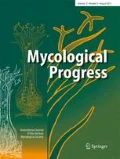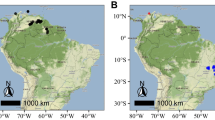Abstract
A new polypore species, Antrodia hyalina, is described from Russia. It is morphologically similar to Antrodia pulvinascens, but differs in having annual, thinner and softer basidiocarps, solid skeletal hyphae, and cylindrical spores. Antrodia leucaena, originally described from China, is reported as new from Finland and Russia on Populus tremula. Antrodia wangii is regarded as a synonym of A. bondartsevae.






Similar content being viewed by others
References
Bernicchia A, Gorjón SP, Vampola P, Ryvarden L, Prodi A (2012) A phylogenetic analysis of Antrodia s.l. based on nrDNA ITS sequences, with emphasis on rhizomorphic European species. Mycol Prog 11:93–100
Binder M, Hibbett DS, Larsson KH, Larsson E, Langer E, Langer G (2005) The phylogenetic distribution of resupinate forms across the major clades of homobasidiomycetes. System Biodivers 3:113–157
Dai YC, Niemelä T (2002) Changbai wood-rotting fungi 13. Antrodia sensu lato. Ann Bot Fenn 39:257–265
Dai YC, Yuan HS, He W, Decock C (2006) Polypores from Beijing area, northern China. Mycosystema 25:368–373
David A, Dequatre B (1985) Antrodia albidoides (Polyporaceae) nouvelle ultraspecies meridionale. Mycol Helv 1:357–369
Gardes M, Bruns TD (1993) ITS primers with enhanced specificity for basidiomycetes—application to the identification of mycorrhizae and rusts. Mol Ecol 2:113–118
Hopple JS Jr, Vilgalys R (1999) Phylogenetic relationships in the mushroom genus Coprinus and dark-spored allies based on sequence data from the nuclear gene coding for the large ribosomal subunit RNA:divergent domains, outgroups, and monophyly. Mol Phylogenet Evol 13:1–19
Katoh K, Kuma K, Toh H, Miyata T (2005) MAFFT version 5: improvement in accuracy of multiple sequence alignment. Nucleic Acids Res 33:511–518
Kim SY, Park SY, Ko KS, Jung HS (2003) Phylogenetic analysis of Antrodia and related taxa based on partial mitochondrial SSU rDNA sequences. Antonie van Leeuwenhoek J Microb Serol 83:81–100
Kim KM, Yoon YG, Jung HS (2005) Evaluation of the monophyly of Fomitopsis using parsimony and MCMC methods. Mycologia 97:812–822
Kim KM, Lee JS, Jung HS (2007) Fomitopsis incarnatus sp. nov. based on generic evaluation of Fomitopsis and Rhodofomes. Mycologia 99:833–841
Kotiranta H, Ushakova N, Mukhin V (2007) Polypore (Aphyllophorales, Basidiomycetes) studies in Russia 2. Central Ural. Ann Bot Fenn 44:103–127
Miettinen O, Niemelä T, Spirin W (2006) Northern Antrodiella species: the identity of A. semisupina, and type studies of related taxa. Mycotaxon 96:211–239
Müller J, Müller K, Quandt D (2010) PhyDE – Phylogenetic Data Editor, version 0.997. http://phyde.de
Nilsson RH, Veldre V, Hartmann M, Unterseher M, Amend A, Bergsten J, Kristiansson E, Ryberg M, Jumpponen A, Abarenkov K (2010) An open source software package for automated extraction of ITS1 and ITS2 from fungal ITS sequences for use in high-throughput community assays and molecular ecology. Fungal Ecol 3:284–287
Nylander JAA (2004) MrModeltest v2.3. Program distributed by the author. Evolutionary Biology Centre, Uppsala University
Palmer JM, Lindner DL, Volk TJ (2008) Ectomycorrhizal characterization of an American chestnut (Castanea dentata)-dominated community in Western Wisconsin. Mycorrhiza 19:27–36
Rajchenberg M, Gorjón SP, Pildain MB (2011) The phylogenetic disposition of Antrodia s.l. (Polyporales, Basidiomycota) from Patagonia, Argentina. Aust Syst Bot 24:111–120
Rivoire B (2010) Antrodia pulverulenta (Basidiomycota, polypore), une espéce nouvelle produisant des amas de mitospores blanches. Bull Soc Linn Lyon 79:185–190
Ryvarden L (1988) Type studies in the Polyporaceae. 20. Species described by J. Bresadola. Mycotaxon 33:303–327
Spirin W (2002) A new Antrodia species. Mikol Fitopatol 36:33–35 (in Russian)
Spirin W (2007) New and noteworthy Antrodia species (Polyporales, Basidiomycota) in Russia. Mycotaxon 101:149–156
Spirin W, Zmitrovich I, Wasser S (2006) Oligoporus balsameus rare Eurasian species, plus notes on some related taxa. Mycotaxon 97:73–82
Tomšovský M, Popelárová P, Baldrian P (2009) Production and regulation of lignocelluloses-degrading enzymes of Poria-like wood-inhabiting basidiomycetes. Folia Microbiol 54:74–80
Vlasák J, Kout J (2011) Pileate Fomitiporia species in the USA. New combinations Fomitiporia calkinsii and F. bakeri. Mycol Prog 4:445–452
White TJ, Bruns T, Lee S, Taylor JW (1990) Amplification and direct sequencing of fungal ribosomal RNA genes for phylogenetics. In: Innis MA, Gelfand DH, Sinisky JJ, White TJ (eds) PCR protocols: a guide to method and application. Academic, San Diego, pp 315–322
Yu ZH, Wu SH, Wang DM, Chen CT (2010) Phylogenetic relationships of Antrodia species and related taxa based on analyses of nuclear large subunit ribosomal DNA sequences. Bot Stud 51:53–60
Acknowledgments
We are grateful to Ellen Larsson (Göteborg), Karl-Henrik Larsson (Oslo), Dmitry Schigel (Helsinki), Beatriz Ortiz-Santana (Madison, WI) and Josef Vlasák (České Budějovice) for providing sequences, to Bernard Rivoire (Orliénas), Ivan Zmitrovich (St. Petersburg), Yu-Cheng Dai (Beijing) and Tatyana Svetlova (Moscow) for specimens, and to Teuvo Ahti (Helsinki) for checking Latin. V.S. was supported by a CIMO fellowship and O.M. by a grant from Ella and Georg Ehrnrooth Foundation and by the NSF grant DEB0933081.
Author information
Authors and Affiliations
Corresponding author
Electronic supplementary material
Below is the link to the electronic supplementary material.
ESM 1
(PDF 35 kb)
Rights and permissions
About this article
Cite this article
Spirin, V., Miettinen, O., Pennanen, J. et al. Antrodia hyalina, a new polypore from Russia, and A. leucaena, new to Europe. Mycol Progress 12, 53–61 (2013). https://doi.org/10.1007/s11557-012-0815-0
Received:
Revised:
Accepted:
Published:
Issue Date:
DOI: https://doi.org/10.1007/s11557-012-0815-0




